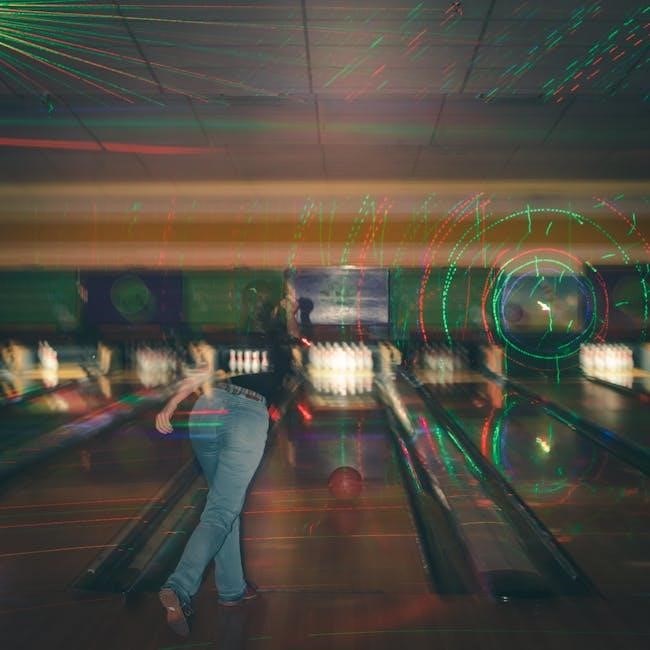Selecting the right bowling ball weight is crucial for optimal performance and comfort. This guide explores the importance of proper weight selection, physics, and dynamics to enhance your game.
1.1 Importance of Choosing the Right Bowling Ball Weight
Selecting the right bowling ball weight is essential for optimal performance, comfort, and injury prevention. A ball that is too heavy can strain muscles, reducing accuracy and endurance, while one that is too light may lack power and consistency. Proper weight ensures smoother delivery, better control, and increased precision, allowing bowlers to maintain consistent performance and enjoy the game more effectively. Choosing the ideal weight is fundamental for improving skills and overall bowling experience.
1.2 Brief Overview of Bowling Ball Physics and Dynamics
Bowling ball physics involves understanding weight distribution, rotational motion, and energy transfer. The ball’s mass, size, and core design influence its momentum and stability. Dynamics include how the ball interacts with the lane surface, with factors like rotation, speed, and oil patterns affecting performance. The coverstock material impacts friction, while the core affects rotation and hook potential. Proper weight ensures efficient energy transfer, enabling consistent delivery and accuracy. These principles are crucial for optimizing ball motion and achieving desired results on the lane.

Factors Influencing Bowling Ball Weight Selection
Age, skill level, physical strength, and endurance are key factors. Personal preference and bowling style also play a role in determining the ideal ball weight for optimal performance.
2.1 Age and Skill Level Considerations
Age and skill level significantly influence bowling ball weight selection. Younger bowlers or beginners often benefit from lighter balls, typically between 6-12 pounds, to ensure proper form and avoid fatigue. Intermediate bowlers may opt for weights between 12-14 pounds, allowing for better control and power. Advanced bowlers, particularly those with higher strength and technique, can handle heavier balls, up to 16 pounds, which provide greater momentum and pin impact. Adjusting weight based on skill level ensures a comfortable and effective bowling experience.
2.2 Physical Strength and Endurance Requirements
Physical strength and endurance play a key role in determining the ideal bowling ball weight. Bowlers with greater strength can manage heavier balls, which generate more power. However, endurance is equally important, as heavier balls can lead to fatigue during longer games. A ball that is too heavy may compromise form and accuracy, while a lighter ball may lack the necessary force. Finding a balance between strength and stamina ensures consistent performance and reduces the risk of injury. Testing different weights helps identify the optimal fit for individual capabilities.
2.3 Personal Preference and Bowling Style
Personal preference and bowling style significantly influence the choice of ball weight. Players with a slower, more controlled approach may favor lighter balls, while power players often prefer heavier ones for increased momentum. Comfort and consistency are key; a ball that feels right ensures better performance. Testing different weights helps bowlers align their style with the optimal ball weight, enhancing accuracy and overall satisfaction. Ultimately, the right weight matches both physical ability and individual technique, creating a seamless bowling experience.
How to Choose the Right Bowling Ball Weight
Test different weights on the lane to find comfort and performance. Consider ball material and core for weight distribution, ensuring optimal balance and control during your game.
3.1 Testing Different Weights on the Lane
Testing different bowling ball weights on the lane is essential to determine the ideal fit for your strength and technique. Start by trying balls within your expected range, focusing on comfort and control; Pay attention to how each weight affects your arm swing, release, and overall performance. Lighter balls may improve accuracy but lack power, while heavier ones increase striking potential yet risk fatigue. Experimenting during practice allows you to identify the optimal weight for consistent, fatigue-free bowling. This hands-on approach ensures a personalized and effective choice tailored to your game.
3.2 Understanding Ideal Weight Ranges for Beginners and Professionals
For beginners, especially younger bowlers, lighter balls between 6 to 14 pounds are recommended to ensure ease of handling and control. Adults typically start within the 10 to 14-pound range, balancing manageability and effectiveness. Professionals and experienced bowlers often opt for heavier balls, typically ranging from 14 to 16 pounds, with some using up to 17 or 18 pounds for enhanced power and speed. These weight ranges accommodate different strength levels, techniques, and personal comfort, helping bowlers achieve optimal performance while minimizing fatigue.
3.3 The Role of Ball Material and Core in Weight Distribution
The core and coverstock of a bowling ball significantly impact weight distribution. The core’s design and density dictate the ball’s motion dynamics. A symmetric core provides consistent balance, while an asymmetric core enhances hook potential. Coverstock materials like urethane, reactive resin, or particle-based solutions influence weight distribution by altering the ball’s interaction with the lane. The combination of core and coverstock ensures optimal performance, helping bowlers achieve desired outcomes based on their style and lane conditions. Proper material selection is key to maintaining consistent weight distribution and overall ball motion.
Maintenance and Care of Bowling Balls

Regular maintenance ensures optimal performance. Clean and polish the ball frequently, store it properly, and inspect for damage to maintain its weight and condition.
4.1 Cleaning and Polishing Techniques
Proper cleaning and polishing are essential for maintaining a bowling ball’s performance. Regularly remove oil and dirt using mild cleaners designed for bowling balls. Avoid harsh chemicals, as they can damage the coverstock. Use a microfiber towel to wipe the ball after each use. Polish the ball periodically to restore its surface texture. Improper cleaning can lead to reduced hook potential and inconsistent weight distribution. Always follow the manufacturer’s guidelines for cleaning products and techniques to ensure the ball remains in optimal condition for consistent performance on the lane.
4.2 Storing Bowling Balls to Maintain Weight Consistency
Proper storage is key to maintaining your bowling ball’s weight consistency. Store the ball in a cool, dry place, avoiding extreme temperatures and humidity. Use a ball return or rack to prevent warping or deformation. Clean the ball thoroughly before storage to remove dirt and oil, which can affect performance over time. Avoid stacking balls or exposing them to direct sunlight, as this can alter the coverstock material. Regularly inspect the ball for damage or wear. Proper storage ensures consistent weight distribution and optimal performance during games.
Common Mistakes to Avoid When Selecting a Bowling Ball Weight
Ignoring physical limitations and lane conditions are common errors. Avoid choosing balls that are too heavy or too light, as this can hinder performance and cause fatigue.
5.1 Ignoring Physical Limitations
One of the most common mistakes is ignoring physical limitations when selecting a bowling ball weight. A ball that is too heavy can lead to fatigue, poor technique, and potential injury. Conversely, a ball that is too light may lack the necessary power for consistent strikes. It is essential to consider factors such as age, strength, and overall health to ensure the chosen weight aligns with your physical capabilities. Neglecting these aspects can result in decreased performance and increased risk of discomfort or harm during the game.
5.2 Overlooking the Impact of Lane Conditions
Lane conditions significantly influence bowling ball performance, yet many bowlers fail to consider their impact. Oil patterns, surface textures, and environmental factors can alter how a ball reacts. Using a ball too heavy or light for specific lane conditions can lead to inconsistent rolls and reduced accuracy. For example, heavier balls may perform better on oily lanes, while lighter balls are more effective on dry surfaces. Ignoring these dynamics can result in suboptimal performance and make achieving consistent strikes more challenging, regardless of skill level or ball quality.

The Future of Bowling Ball Technology and Weight Innovations
Advances in materials and manufacturing are revolutionizing bowling ball technology, with innovations like adjustable weights and customizable cores enhancing performance for bowlers of all skill levels.
6.1 Advances in Ball Materials and Manufacturing
Modern bowling ball technology is evolving rapidly, with innovations in materials like nanocomposite urethane and hybrid covers. These advancements improve durability and provide consistent performance across various lane conditions. Manufacturers are also experimenting with lightweight, high-strength cores that enhance energy transfer and stability. Additionally, 3D printing is being explored for creating customized ball structures, allowing for precise weight distribution and personalized feel. These breakthroughs ensure bowlers can optimize their game with cutting-edge equipment designed for peak performance and adaptability.
6.2 Customizable Weight Options for Enhanced Performance
Customizable bowling balls now offer adjustable weight options, allowing bowlers to fine-tune their equipment. Innovative core systems enable weight redistribution without altering the ball’s overall dynamics; This technology benefits bowlers of all levels, providing optimal control and power. Adjustable weights can be increased or decreased based on lane conditions and personal preference, ensuring a consistent performance. These advancements cater to individual needs, making bowling more accessible and enjoyable while maintaining high standards of precision and reliability.
Selecting the right bowling ball weight is a balance of personal fit, performance, and comfort. Always test different weights on the lane to ensure proper control and power. Prioritize your physical strength and skill level to avoid fatigue or injury. Regular maintenance, such as cleaning and storing the ball correctly, ensures consistent performance. By considering these factors and staying informed about advancements, you can optimize your game and enjoy a more satisfying bowling experience at every level.